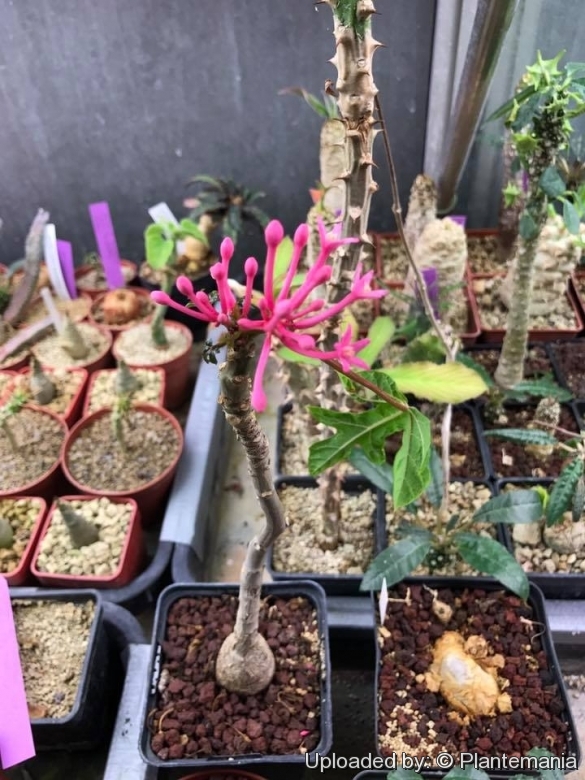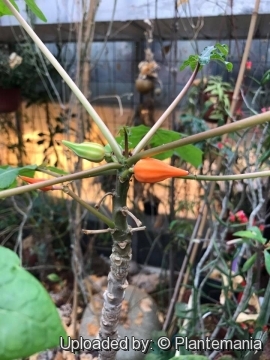Accepted Scientific Name: Carica parviflora (A.DC.) Solms
Fl. Bras. (Martius) 13(3): 177 1889. Mart.

Vasconcellea parviflora (Carica parviflora) Photo by: © Plantemania
Origin and Habitat: Carica parvifloraSN|33885]]SN|33885]] (Vasconcellea parvifloraSN|33887]]SN|33887]]) is endemic to the Pacific Andean slopes of Southern Ecuador and North Western Peru.
Habiatat and ecology: This species grows in semi-arid and arid places from sea level up to 1500 metres.
Synonyms:
See all synonyms of Carica parviflora
back
Accepted name in llifle Database:Carica parviflora (A.DC.) SolmsFl. Bras. (Martius) 13(3): 177 1889.Synonymy: 6
back
Common Names include:
SPANISH (Español): coral, palo de yuca, sacha papaillo, papaillo, yuca de monte
Description: Carica parvifloraSN|33886]]SN|33885]] (often placed in genus Vasconcellea) is a large-leaved, deciduous pachycaul shrub to 50 cm tall or a small tree up to 2(-3) metres hight, frequently flowering when leaf-less. This species produces tiny bright orange fruit, stunning pink/purple flowers, but the fruits have very little edible flesh. Typically the young plants have a globose-elongate swelling at stem base, also known as a caudex. Carica parviflora is a dioecious species with female and male individuals. Both male and female flowers are morphologically similar to those of papaya (Carica papaya).
Stem: Usually simple unbranched, (except where it has been injured). The base of the trunk is globose-elongate and store water during drought, the bark is greyish, and smooth.
Leaves: Glabrous, lighter green beneath, 10-30 cm long, 6-25 cm wide, narrowly ovate to almost round in outline, appearing peltate by the overlapping sinuate lower lobes, basally cordate, irregularly 3-, 5-, 7- to 9-lobed, the lower lobes sometimes overlapping, all lobes obovate entire or again 3-lobed to pinnatilobed, acute to acuminate. Petiole 8-20 cm long.
Inflorescence: Paniculate, lax or contracted, 1-12 cm long, often pinkish. Male inflorescence long-peduncled, many-flowered, the pedicels 2 mm.
Flowers: Small and delicate bright pink/purple or rose-red coloured, calyx minute, corolla tube 8-13 mm long, more than 3 time as long as the lobes, villous within, the lobes 3-4 mm. long, ovate-oblong. Male flowers sessile or almost so (less than 2 mm), female flowers pedicellate 4-7 mm. Upper stamens apically 1-glandular, the connective of the anthers of the lower shortly produced.
Fruits: Small, 2-2.5 cm long, x 1-1.2 cm in diameter, narrowly ovoid, yellowish to reddish, porrect, of sweet-sour taste.
Seeds: Ovoid, 5-6 mm long.
Chromosome number: 2n = 2x = 18
Taxonomy notes: According to Solms-Laubach, Carica paniculataSN|33885]]SN|33886]] Spruce is distinguishable, from C. parviflora by the divergent lobes of the leaves, but the name C. paniculata is not accepted by many botanists that treat it as synonym.
Bibliography: Major references and further lectures
1) Urs Eggli “Illustrated Handbook of Succulent Plants: Dicotyledons” Springer Science & Business Media, 2002.
2) Fieldiana: Botany, Volume 8, Part 4, Ed. 1;Volume 13, Part 4, Ed. 1 Field Museum of Natural History, 1941
3) Susanna Lyle “Fruit & nuts: a comprehensive guide to the cultivation, uses and health benefits of over 300 food-producing plants” Timber Press, 20 March 2006
4) SMITHSONIAN INSTITUTION
5) John L. Clark, David A. Neill and Mercedes Asanza “Floristic Checklist of the Mache-Chindul Mountains of Northwestern Ecuador” Contributions from the United States National Herbarium, Volume 54: 1-180 Department of Botany National Museum of Natural History Washington, DC 2006
6) Marina Iovene, Qingyi Yu, Ray Ming, and Jiming Jiang “Evidence for Emergence of Sex-Determining Gene(s) in a Centromeric Region in Vasconcellea parviflora” Genetics. 2015 Feb; 199(2): 413–421. Published online 2014 Dec 5. https://www.ncbi.nlm.nih.gov/pmc/articles/PMC4317651/
7) “Informe diversidad de frutales nativos comestibles caricaceae – Iniap” http://www.iniap.gob.ec/nsite/images/documentos/INFORMEDIVERSIDAD_FRUTALES_NATIVOS_COMESTIBLES_CARICACEAE_SOLANACEAE_FENOLOGIA_USOS_RECOLECCION_GERMOPLASMA_SUR_ECUADOR.pdf
 Vasconcellea parviflora (Carica parviflora) Photo by: © Plantemania
Vasconcellea parviflora (Carica parviflora) Photo by: © PlantemaniaSend a photo of this plant.The gallery now contains thousands of pictures, however it is possible to do even more. We are, of course, seeking photos of species not yet shown in the gallery but not only that, we are also looking for better pictures than those already present.
Read More... Cultivation and Propagation: Beloved by collectors, Carica parvifloraSN|33885]]SN|33885]] (Vasconcellea parvifloraSN|33887]]SN|33887]]) is cultivated mainly for its very striking rose-red blooms. It is an excellent caudiciform plant and it should make an interesting addition to a collection.











